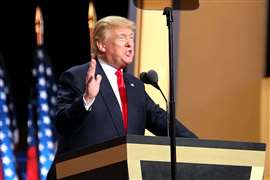Read this article in Français Deutsch Italiano Português Español
Trump’s planned 25% tariff on goods from Canada, Mexico could impact construction
26 November 2024
In a social media post delivered on Monday, 25 November, US President-elect Donald Trump committed to a 25% tariff on all goods imported from Canada and Mexico, with a promise to sign an executive order on the matter on his first day in office, 20 January.
 President-elect Donald Trump. Trump speaks on a phone during his first term in a photo dated November 2018. (Image: Greg Lovett/Palm Beach Post/USA TODAY NETWORK via Imagn Images and Reuters Connect)
President-elect Donald Trump. Trump speaks on a phone during his first term in a photo dated November 2018. (Image: Greg Lovett/Palm Beach Post/USA TODAY NETWORK via Imagn Images and Reuters Connect)
Trump wrote on social media, “As one of my many first executive orders, I will sign all necessary documents to charge Mexico and Canada a 25% tariff on all products coming into the United States.”
Trump also announced plans to levy an additional 10% tariff on all Chinese goods imported into the country, which will be in addition to existing sector-targeted tariffs already in place.
Notably, news sources claimed sources close to Trump had confirmed crude oil would not be exempt good and subject to the tariffs.
What will Trump’s North American tariffs mean for construction?
The three largest suppliers of goods to the US are the triad of countries that Trump has selected for his tariff programme. It’s estimated that about US$5.1 trillion is imported into the US annually from Canada, China and Mexico. This accounts for about 42% of all imported goods to America in a given year.
 Flags of North America: from left, Canada, the US and Mexico. (Image: Adobe Stock)
Flags of North America: from left, Canada, the US and Mexico. (Image: Adobe Stock)
But economists and construction leadership have warned that the effects of enacting such tariffs are currently “unclear” and could be a net negative long-term for both the US economy as a whole and the built environment.
UK-based Oxford Economics, an independent economic advisory firm, issued a report earlier this month prior to Trump’s 25 November announcement. In the report, the firm believed a more “toned-down policy shift” on tariffs were forthcoming, although the president-elect’s recent statements suggest he, instead, favours a more “extreme” plan.
Even the “toned-down” tariffs, Oxford Economics said, “will drag down total exports from targeted economies in the medium term, with the impact concentrated on specific sectors such as automobiles and steels.
“This will naturally weigh on construction of warehousing and manufacturing facilities in these countries. The ensuing trade diversion and substitution will boost exports – and therefore construction of manufacturing and warehousing facilities – in other countries.”
The firm noted that tariffs could take nearly one year to implement via legislation, which means the true impact may not be seen or felt until 2026.
How will OEMs be impacted?
Materials may be more expensive to acquire across the board, but some US-based original equipment manufacturers (OEMs) of construction equipment may be in for more headaches than their peers.
For example, Bobcat announced it broke ground on a $300-million facility in Salinas Victoria, Neuvo Leon, Mexico, in June. The planned 65,032m2 manufacturing plant is set to produce compact track and skid-steer loaders. A communications representative from Bobcat told Construction Briefing the company was unable to comment at this time, noting it was “too early to know what will or will not take effect with the new, incoming administration.”
Caterpillar has multiple facilities in Mexico including a parts distribution centre, a components manufacturing site and six principal manufacturing plants. The company opened its first facility in Mexico in 1962. The OEM did not respond to a request to comment.
Trump’s tariffs may not hurt China much, could have broad impact in Asia
 Representative image of China and US at the negotiation table. (Image: Adobe Stock)
Representative image of China and US at the negotiation table. (Image: Adobe Stock)
Oxford Economics went on to say that the Chinese have previously circumvented tariffs levied by foreign countries successfully, and the firm expects they’ll do so again.
“The impact of tariffs on China is not necessarily negative in the near-term, as it appears China may be getting around tariffs by exporting goods to a third country that are then adding some value, perhaps packaging, and then sending the same goods to the US market,” explained the Oxford Economics report.
But there could be some downsides for China and its Belt and Road infrastructure initiative, particularly if internal strife in the real estate market continues. “If the tariffs were to weaken the Chinese economy, they could limit the government’s ability to provide additional support for the ailing real estate sector. This, combined with the ongoing transition away from an investment-led economy may weigh on China’s appetite for foreign investment, which could see more Belt and Road Initiative projects delayed or cancelled.”
If this were the scenario, Oxford Economics said it could lead to a general dip in construction activity throughout Africa and the Asia Pacific regions.
And one China-based OEMs could also suffer other impacts from the move. For example, XCMG, like Bobcat, announced this year it is investing in and constructing a manufacturing plant in Mexico, which would be its second in the region. XCMG did not return a request for comment.
How have other countries responded to Trump’s proposed tariffs?
 Mexico President Claudia Sheinbaum. (Image via Reuters Connect)
Mexico President Claudia Sheinbaum. (Image via Reuters Connect)
Officials from Mexico, Canada and China and major industry groups warned that President-elect Donald Trump’s threat of hefty tariffs on goods would harm the economies of all involved, causing inflation to spike and damaging job markets.
“To one tariff will follow another in response and so on, until we put our common businesses at risk,” Mexican President Claudia Sheinbaum said during a regular press conference. Sheinbaum said she planned to send a letter to Trump and would seek a call with him to discuss the issue.
The threatened levies would appear to violate the terms of the US-Mexico-Canada Agreement (USMCA) on trade. The deal, which Trump signed into law, took effect in 2020 and continued the largely duty-free trade between the three North American countries; the deal sunsets in 2026.
Warren Maruyama, former general counsel for the US Trade Representative under President George H.W. Bush, said Trump’s threat could be acted on with relative ease by declaring a national emergency, which would unlock the International Emergency Economic Powers Act. “If precedent is any indication, it’s a serious uphill fight” to challenge actions taken under that umbrella, he said.
A Bank of Canada official said that any move by Trump to deliver on the threat would reverberate on both sides of the US northern border.
“What happens in the US has a big impact on us, and something like this would clearly have an impact on both economies,” Deputy Governor Rhys Mendes said during an audience question-and-answer session in Charlottetown, Prince Edward Island.
A spokesperson for China’s embassy in Washington said: “No one will win a trade war or a tariff war.”
STAY CONNECTED


Receive the information you need when you need it through our world-leading magazines, newsletters and daily briefings.
CONNECT WITH THE TEAM













